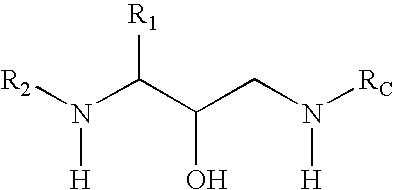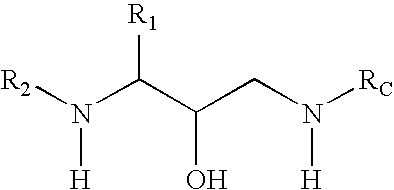Methods of treatment of amyloidosis using bi-cyclic aspartyl protease inhibitors
a technology of protease inhibitors and amyloidosis, which is applied in the direction of heterocyclic compound active ingredients, biocide, drug compositions, etc., can solve the problems of unsuitable compounds for treatment, no known effective treatments for preventing, delaying, stopping or reversing the progression of alzheimer's disease, and unable to cross the blood-brain barrier or great difficulty of known aspartyl protease inhibitors, etc., to achiev
- Summary
- Abstract
- Description
- Claims
- Application Information
AI Technical Summary
Benefits of technology
Problems solved by technology
Method used
Image
Examples
example 1
GENERAL SCHEME: PREPARATION OF REPRESENTATIVE COMPOUNDS OF FORMULA (I)
[0235]
[0236] Aniline 1-1 is alkylated with a halide 1-2B or acrylate 1-2A to give 1-3. 1-3 is then treated with a strong acid or with a Lewis acid at temperatures ranging from 0° C. to 140° C., preferably with phosphorus pentoxide and methanesulfonic acid at 130° C., to give ketone 1-4. The nitrogen of 1-4 is then either protected with a protecting group, many of which are listed in Protective Groups in Organic Synthesis, Greene and Wuts, 3rd edition, 1999, Wiley-Interscience, or is substituted with an alkyl group, an acyl group, or a sulfonyl group. Protected ketone 1-5 may be prepared using Ra-Z via routes known in the art. Another alternative route of preparing 1-5 uses 1-4 with Rb as hydrogen. Halogenation with halogenating reagents such as N-bromosuccinimide, N-iodosuccinimide, dibromatin, and the like results in 1-4A where Rb is preferably bromine or iodine. Treatment of 1-4A under cross coupling conditions...
example 2
PREPARATION OF N-{(1S,2R)1-(3,5-DIFLUOROBENZYL)-3-[(6-ETHYL-1,2,3,4-TETRAHYDROQUINOLIN-4-YL)AMINO]-2-HYDROXYPROPYL)ACETAMIDE
[0240]
Step 1. PREPARATION OF ETHYL N-(4-ETHYLPHENYL)-BETA-ALANINATE
[0241]
[0242] Ethyl acrylate (10.8 g) was added to a solution of 4-ethyl aniline (10.0 g) in acetic acid (25 mL). The mixture was heated to 80° C. for 2 h. Additional ethyl acrylate (1.0 mL) was added, and the mixture was again heated to 80° C. for 1 h. The mixture was allowed to cool to room temperature and stir for 2 days. Sodium hydroxide (8N) was added until the pH reached 9. The mixture was partitioned between dichloromethane and water and the combined organics were washed with 1 N sodium hydroxide, brine, dried (sodium sulfate), filtered, and concentrated. The mixture was chromatographed eluting with a 20:80 ethyl acetate:heptane solvent solution. A mixture of the mono and di-ester product (19.5 g) was obtained (1:1 mixture). MS (ESI+) for C13H19NO2 m / z 221.99 [M+H]+.
Step 2. PREPARATION ...
example 3
PREPARATION OF N-{(1S,2R)-1-(3,5-DIFLUOROBENZYL)-3-[(6-ETHYL-1-METHYL-1,2,3,4-TETRAHYDROQUINOLIN-4- YL)AMINO]-2-HYDROXYPROPYL}ACETAMIDE
[0257]
Step 1. PREPARATION OF ETHYL N-(4-ETHYLPHENYL)-BETA-ALANINATE
[0258] Ethyl acrylate (8.26 g) was added to a solution of 4-ethyl aniline (10.00 g) in acetic acid (20 mL). The mixture was heated to 70° C. for 3.5 h. The mixture was allowed to cool to room temperature. The mixture was partitioned between dichloromethane and water. The combined organic extracts were washed with brine, dried (sodium sulfate), filtered, and concentrated. The product was used in the next step without further purification. MS (ESI+) for C13H19NO2 m / z 223.1 [M+H]+.
Step 2. PREPARATION OF 6-ETHYL-2,3-DIHYDROQUINOLIN-4(1H)-ONE
[0259]
[0260] Phosphorus pentoxide (11.14 g) in methane sulfonic acid (114 mL) was stirred at 130° C. until it dissolved. The mixture was allowed to cool for 15 min, and ethyl N-(4-ethylphenyl)-beta-alaninate (11.14 g of mono and di-ester mixture) w...
PUM
| Property | Measurement | Unit |
|---|---|---|
| temperatures | aaaaa | aaaaa |
| temperatures | aaaaa | aaaaa |
| pressures | aaaaa | aaaaa |
Abstract
Description
Claims
Application Information
 Login to view more
Login to view more - R&D Engineer
- R&D Manager
- IP Professional
- Industry Leading Data Capabilities
- Powerful AI technology
- Patent DNA Extraction
Browse by: Latest US Patents, China's latest patents, Technical Efficacy Thesaurus, Application Domain, Technology Topic.
© 2024 PatSnap. All rights reserved.Legal|Privacy policy|Modern Slavery Act Transparency Statement|Sitemap



